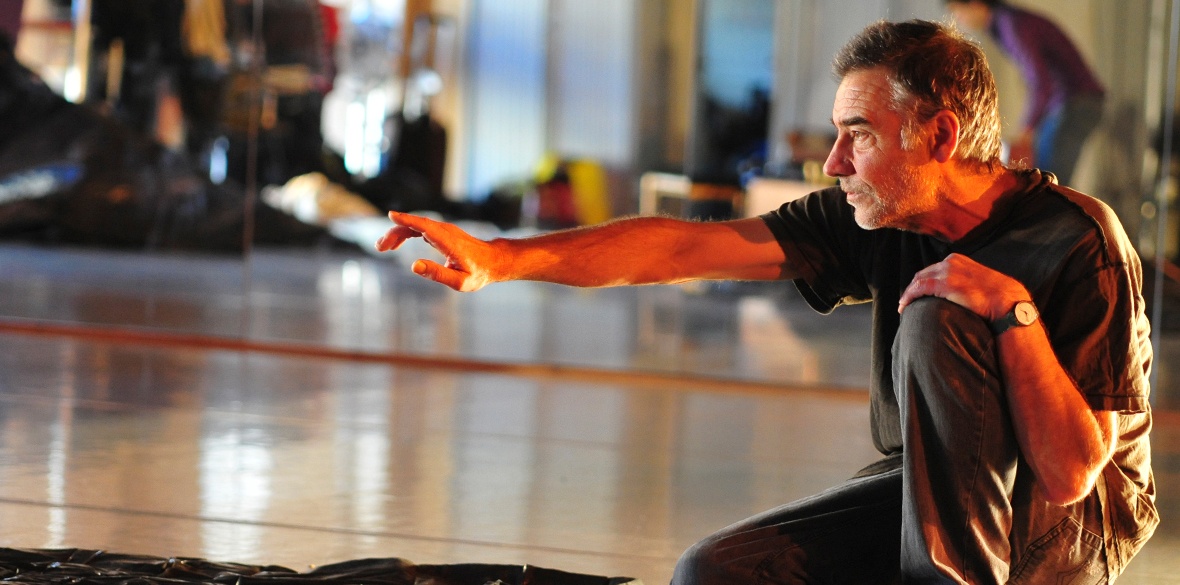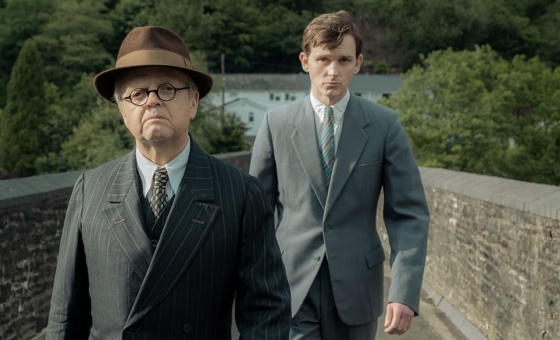This is the last article you can read this month
You can read more article this month
You can read more articles this month
Sorry your limit is up for this month
Reset on:
Please help support the Morning Star by subscribing here
THE Ian Spink Group emerged in London circa 1980. The troupe’s flyers featured an image of an unpeopled thoroughfare curving away enigmatically, yet the show the image heralded was (as I then saw) rich with dancing, new music and handmade design.
Dead Flight fixes in my memory, with its installed transverse section of aircraft fuselage and its pencil-skirted crew enacting deadpan variations on post-armageddon duck-and-cover scenarios.
I caught The Blue Table, a bureaucratic flourish featuring cashmere twinsets, filing cabinets, handbags, dog-biscuits, and verbal patter.
There was also compositional abstraction in the agile form of the through-danced Canta, with its looped trance-inducing David Cunningham score.
Spink and his collaborators pulled this kind of thing off in small-scale venues and with modest resources. Calibration was always strong. Spink’s choreography was lucid and to the point so that his input never rambled over the commissioned soundscapes or artwork. Everything shone. Everything sang out.
Spink trained with Australia’s established national ballet, where innate talent for handling choreographic material would need to manifest, so that dance-making experience could be offered through increments of a repertory set-up.
Before shifting to Britain’s burgeoning independent scene, Spink toured Australia as an apprentice/observer with Merce Cunningham’s dance company.
The John Cage/Merce Cunningham collaborative model uniquely (and sometimes apocalyptically) places media in singular space and time.
Audiences freely navigate the experience. Immersion in this kind of thing is formative and could be overwhelming, except where you do eventually get to be your endearing self.
Open-ended plural response would forever interest Spink; amid his own mode of incisive focus.
As a curious young dancer, I sought out the Spink Group and joined them for morning practice.
Spink led a detailed Cunningham technique class, with emphasis on efficient weight-transfer and co-ordinated swing. I thrived. I could give it the max.
Soon after, Spink merged and expanded his group with those of choreographers Siobhan Davies and Richard Alston to form Second Stride.
Spink auditioned me. I left the Royal Ballet to step into his elegant productions including Canta and the partly improvised Some Fugues (to Bach) plus I danced with Spink and with Jeremy Nelson in the revived De Gas — a hauntingly droll ritual enaction of reverse-striptease (sock suspenders, cufflinks, wing collars and all) culminating in impressions of the bathhouse and ballet salon.
For this, their 1982 company launch, we at Second Stride danced a full repertory of works by Alston/Davies/Spink in a preposterously swift coup.
Drawn by quality (or audacity?) the then nascent Channel 4 stepped up to record and broadcast the work.
Enjoyment of dancing for Spink resided in the way his moves offered satisfying fluency — this was never strenuous but there was brinkmanship: his accumulative sequences (and their reasons) edged us.
The challenge of mustering and rendering such things step at a time for the camera vexed us but absorbed Spink. Hurdles could become matters of interest and fuel versatile gambits.
In this vein, Spink soon found fascination in enabling dancers to devise and speak complex texts with an authenticity akin to their mastery of choreographed movement.
Our paths diverged but a decade on I would dance for Spink in new productions with English National Opera, having by then also seen his acclaimed interdisciplinary works; summits probably being the Judith Weir opera The Vanishing Bridegroom and The Skriker at the National Theatre as well as Bosendorfer Waltzes (a treatise on surrealism) and The Lives of The Great Poisoners, which did what it said on the toxic tin.
Malleable, makeshift, volatile or zealous spadework; such multimedia qualities only stabilise together amid great fascination and skill. His charismatic mild madness and wry way with words helped everyone who worked with Spink, fostering our eagerness for further chances.
Citymoves in Aberdeen is a studio facility where artists generate and practice new work. Spink was artistic director there (2005-10) instigating Dance Live, Aberdeen’s ongoing annual contemporary dance festival and Fast and Dirty — a regular meet where no-strings collaborations are figured out and mounted.
Spink was found vital and amenable at Citymoves, as elsewhere in Scotland and The Work Room (Glasgow) recently hosted an impromptu event to celebrate his work.
There he witnessed a broad contingent of connected local dance artists performing an aleatory piece devised by his frequent collaborator, the sound artist Bill Thompson.
I saw in this a healthy manifestation of fluency and edge. Dancers feel right at such moments. They are their best selves.
London-based former collaborators including Siobhan Davies, Caryl Churchill and designer Anthony MacDonald were present at the gathering.
Archive footage was aired. Personal testament was given. Strikingly, these then/now/north/south elements had not mingled before. There was a sense of discovery where everything shone, everything sang out.
DanceLive Festival 2023
Lynn Shaw, Dancelive manager, writes: “Citymoves are excited to present our annual festival of dance. Our programme supports and celebrates local, Scottish, national and international artists.
“This year, we want to thank and acknowledge the founder of DanceLive Festival, Ian Spink, and to celebrate Ian’s determination and creative vision to bring innovative dance to the north-east of Scotland.
“The festival has allowed an ongoing platform for dance artists and companies to showcase work here, while creating opportunities for audiences to journey into Aberdeen and locals to witness the joy of dance on their doorstep. Thank you, Ian.”
Dancelive Festival runs from October 18-22 2023. For more information see: citymoves.org.uk.











